Organizational Behavior Assignment: Motivation, Teams, & Pay
VerifiedAdded on 2022/09/10
|5
|1107
|20
Homework Assignment
AI Summary
This assignment solution delves into key concepts of organizational behavior, addressing questions related to motivation, merit pay, job characteristics, and teamwork. The student explores the expectancy theory of motivation, analyzing its elements and impact on achieving goals. The discussion includes the benefits and limitations of merit pay systems, along with recommendations for effective implementation. The solution also examines core job characteristics derived from the job characteristics model and self-determination theory (SDT), highlighting the importance of autonomy, relatedness, and competence in employee motivation. Finally, the assignment analyzes the factors contributing to effective teamwork, such as independence, task nature, and team member roles, using a video example to illustrate these principles. The assignment is well-structured and provides relevant references to support the analysis.
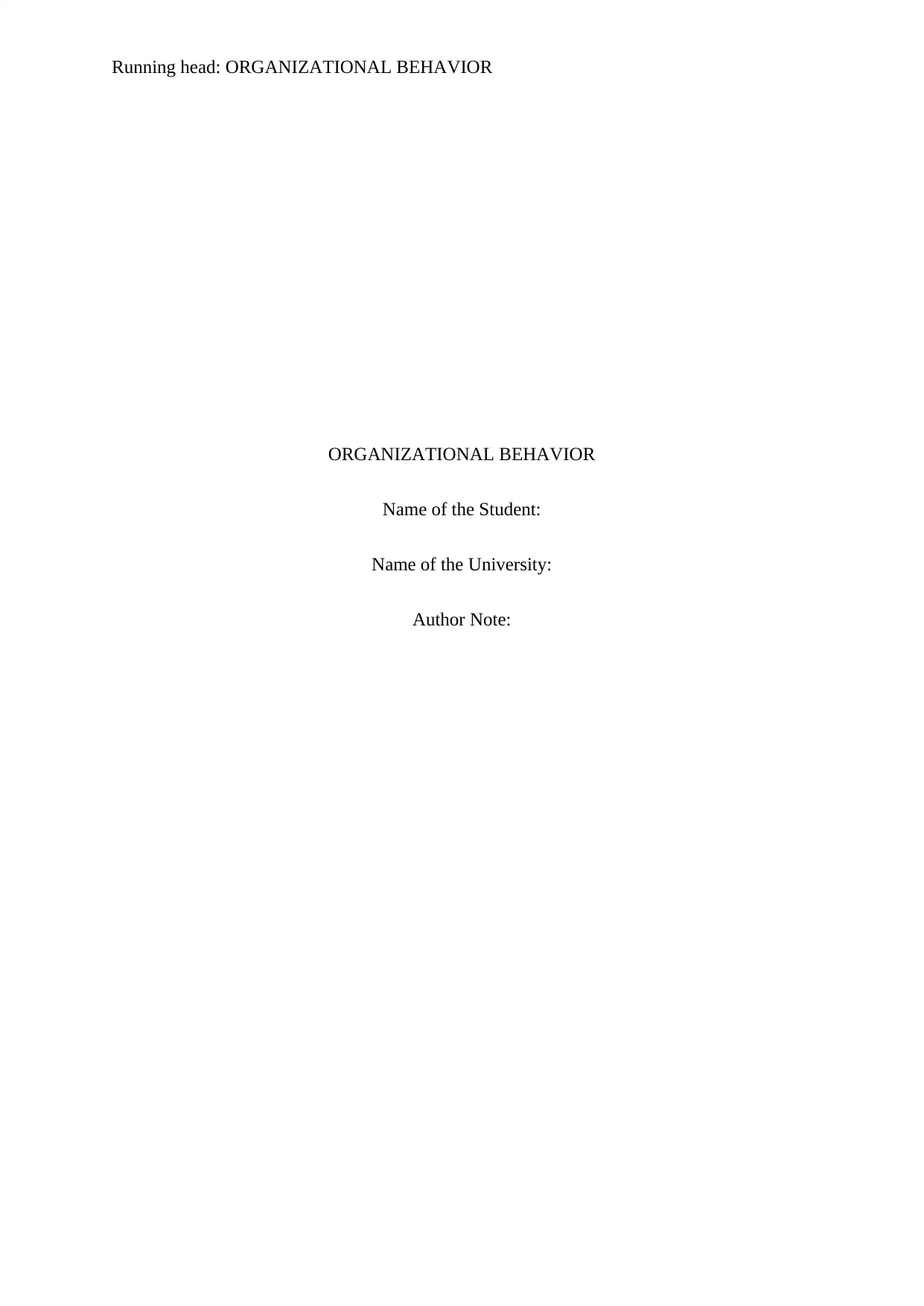
Running head: ORGANIZATIONAL BEHAVIOR
ORGANIZATIONAL BEHAVIOR
Name of the Student:
Name of the University:
Author Note:
ORGANIZATIONAL BEHAVIOR
Name of the Student:
Name of the University:
Author Note:
Paraphrase This Document
Need a fresh take? Get an instant paraphrase of this document with our AI Paraphraser
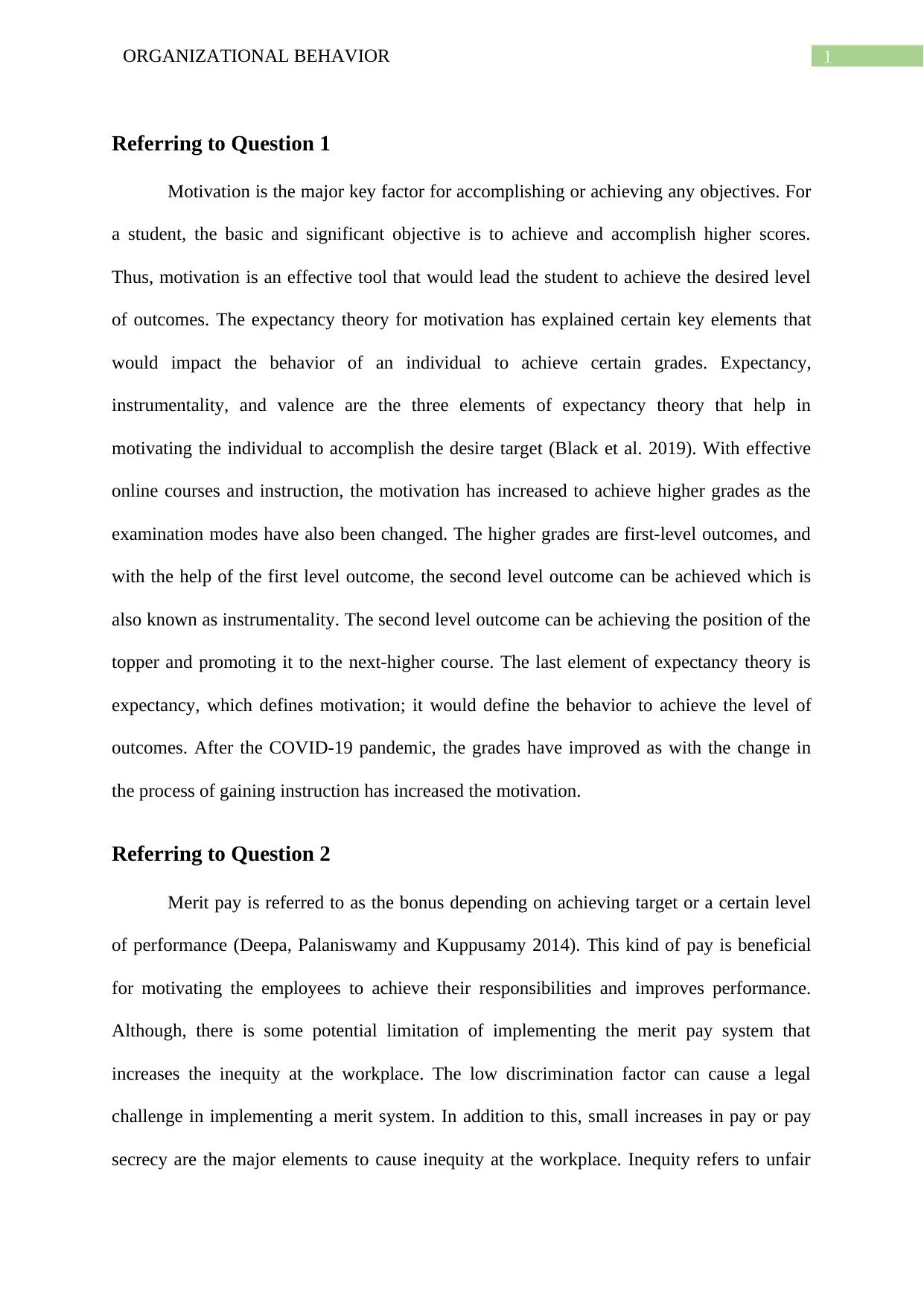
1ORGANIZATIONAL BEHAVIOR
Referring to Question 1
Motivation is the major key factor for accomplishing or achieving any objectives. For
a student, the basic and significant objective is to achieve and accomplish higher scores.
Thus, motivation is an effective tool that would lead the student to achieve the desired level
of outcomes. The expectancy theory for motivation has explained certain key elements that
would impact the behavior of an individual to achieve certain grades. Expectancy,
instrumentality, and valence are the three elements of expectancy theory that help in
motivating the individual to accomplish the desire target (Black et al. 2019). With effective
online courses and instruction, the motivation has increased to achieve higher grades as the
examination modes have also been changed. The higher grades are first-level outcomes, and
with the help of the first level outcome, the second level outcome can be achieved which is
also known as instrumentality. The second level outcome can be achieving the position of the
topper and promoting it to the next-higher course. The last element of expectancy theory is
expectancy, which defines motivation; it would define the behavior to achieve the level of
outcomes. After the COVID-19 pandemic, the grades have improved as with the change in
the process of gaining instruction has increased the motivation.
Referring to Question 2
Merit pay is referred to as the bonus depending on achieving target or a certain level
of performance (Deepa, Palaniswamy and Kuppusamy 2014). This kind of pay is beneficial
for motivating the employees to achieve their responsibilities and improves performance.
Although, there is some potential limitation of implementing the merit pay system that
increases the inequity at the workplace. The low discrimination factor can cause a legal
challenge in implementing a merit system. In addition to this, small increases in pay or pay
secrecy are the major elements to cause inequity at the workplace. Inequity refers to unfair
Referring to Question 1
Motivation is the major key factor for accomplishing or achieving any objectives. For
a student, the basic and significant objective is to achieve and accomplish higher scores.
Thus, motivation is an effective tool that would lead the student to achieve the desired level
of outcomes. The expectancy theory for motivation has explained certain key elements that
would impact the behavior of an individual to achieve certain grades. Expectancy,
instrumentality, and valence are the three elements of expectancy theory that help in
motivating the individual to accomplish the desire target (Black et al. 2019). With effective
online courses and instruction, the motivation has increased to achieve higher grades as the
examination modes have also been changed. The higher grades are first-level outcomes, and
with the help of the first level outcome, the second level outcome can be achieved which is
also known as instrumentality. The second level outcome can be achieving the position of the
topper and promoting it to the next-higher course. The last element of expectancy theory is
expectancy, which defines motivation; it would define the behavior to achieve the level of
outcomes. After the COVID-19 pandemic, the grades have improved as with the change in
the process of gaining instruction has increased the motivation.
Referring to Question 2
Merit pay is referred to as the bonus depending on achieving target or a certain level
of performance (Deepa, Palaniswamy and Kuppusamy 2014). This kind of pay is beneficial
for motivating the employees to achieve their responsibilities and improves performance.
Although, there is some potential limitation of implementing the merit pay system that
increases the inequity at the workplace. The low discrimination factor can cause a legal
challenge in implementing a merit system. In addition to this, small increases in pay or pay
secrecy are the major elements to cause inequity at the workplace. Inequity refers to unfair
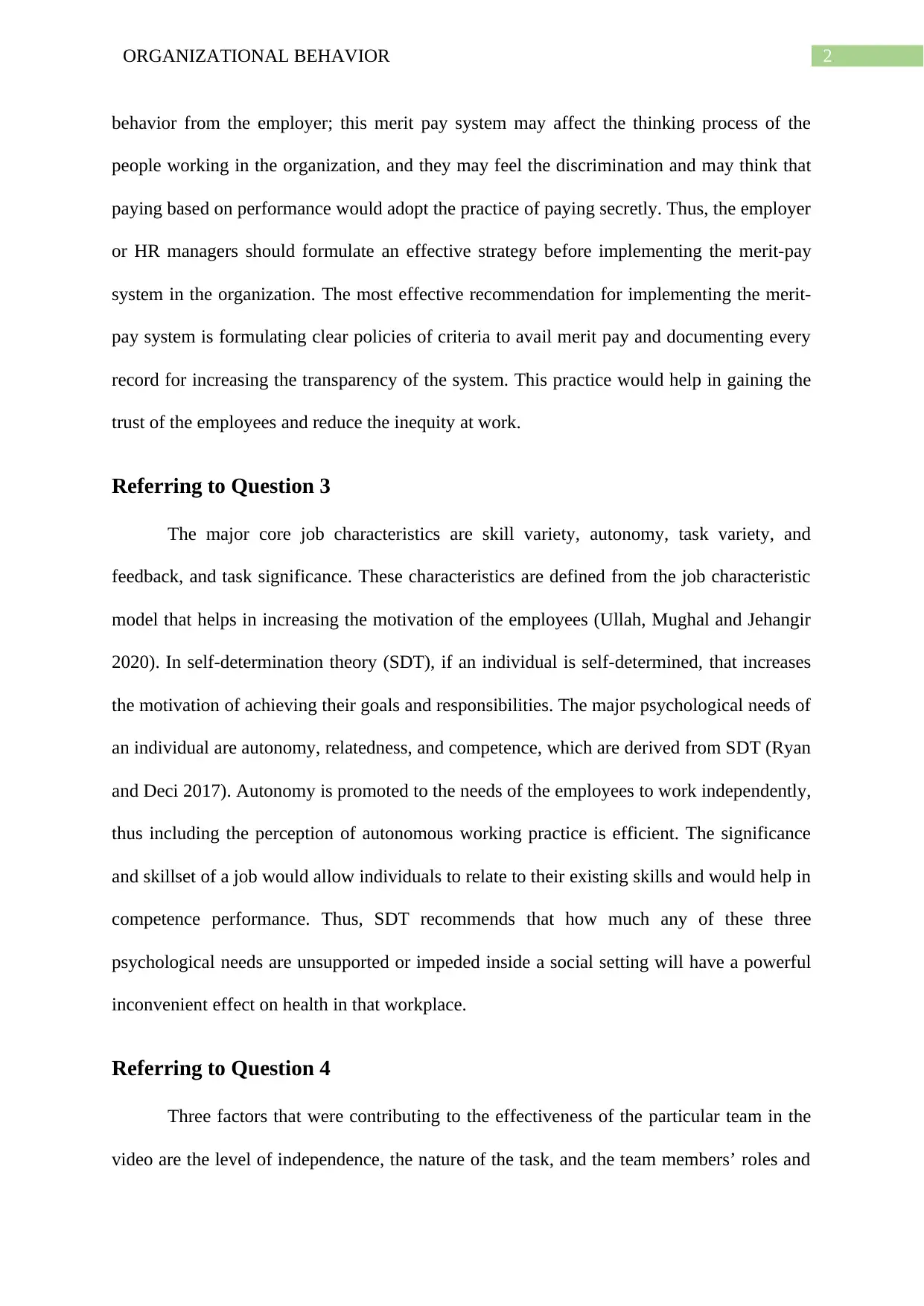
2ORGANIZATIONAL BEHAVIOR
behavior from the employer; this merit pay system may affect the thinking process of the
people working in the organization, and they may feel the discrimination and may think that
paying based on performance would adopt the practice of paying secretly. Thus, the employer
or HR managers should formulate an effective strategy before implementing the merit-pay
system in the organization. The most effective recommendation for implementing the merit-
pay system is formulating clear policies of criteria to avail merit pay and documenting every
record for increasing the transparency of the system. This practice would help in gaining the
trust of the employees and reduce the inequity at work.
Referring to Question 3
The major core job characteristics are skill variety, autonomy, task variety, and
feedback, and task significance. These characteristics are defined from the job characteristic
model that helps in increasing the motivation of the employees (Ullah, Mughal and Jehangir
2020). In self-determination theory (SDT), if an individual is self-determined, that increases
the motivation of achieving their goals and responsibilities. The major psychological needs of
an individual are autonomy, relatedness, and competence, which are derived from SDT (Ryan
and Deci 2017). Autonomy is promoted to the needs of the employees to work independently,
thus including the perception of autonomous working practice is efficient. The significance
and skillset of a job would allow individuals to relate to their existing skills and would help in
competence performance. Thus, SDT recommends that how much any of these three
psychological needs are unsupported or impeded inside a social setting will have a powerful
inconvenient effect on health in that workplace.
Referring to Question 4
Three factors that were contributing to the effectiveness of the particular team in the
video are the level of independence, the nature of the task, and the team members’ roles and
behavior from the employer; this merit pay system may affect the thinking process of the
people working in the organization, and they may feel the discrimination and may think that
paying based on performance would adopt the practice of paying secretly. Thus, the employer
or HR managers should formulate an effective strategy before implementing the merit-pay
system in the organization. The most effective recommendation for implementing the merit-
pay system is formulating clear policies of criteria to avail merit pay and documenting every
record for increasing the transparency of the system. This practice would help in gaining the
trust of the employees and reduce the inequity at work.
Referring to Question 3
The major core job characteristics are skill variety, autonomy, task variety, and
feedback, and task significance. These characteristics are defined from the job characteristic
model that helps in increasing the motivation of the employees (Ullah, Mughal and Jehangir
2020). In self-determination theory (SDT), if an individual is self-determined, that increases
the motivation of achieving their goals and responsibilities. The major psychological needs of
an individual are autonomy, relatedness, and competence, which are derived from SDT (Ryan
and Deci 2017). Autonomy is promoted to the needs of the employees to work independently,
thus including the perception of autonomous working practice is efficient. The significance
and skillset of a job would allow individuals to relate to their existing skills and would help in
competence performance. Thus, SDT recommends that how much any of these three
psychological needs are unsupported or impeded inside a social setting will have a powerful
inconvenient effect on health in that workplace.
Referring to Question 4
Three factors that were contributing to the effectiveness of the particular team in the
video are the level of independence, the nature of the task, and the team members’ roles and
⊘ This is a preview!⊘
Do you want full access?
Subscribe today to unlock all pages.

Trusted by 1+ million students worldwide
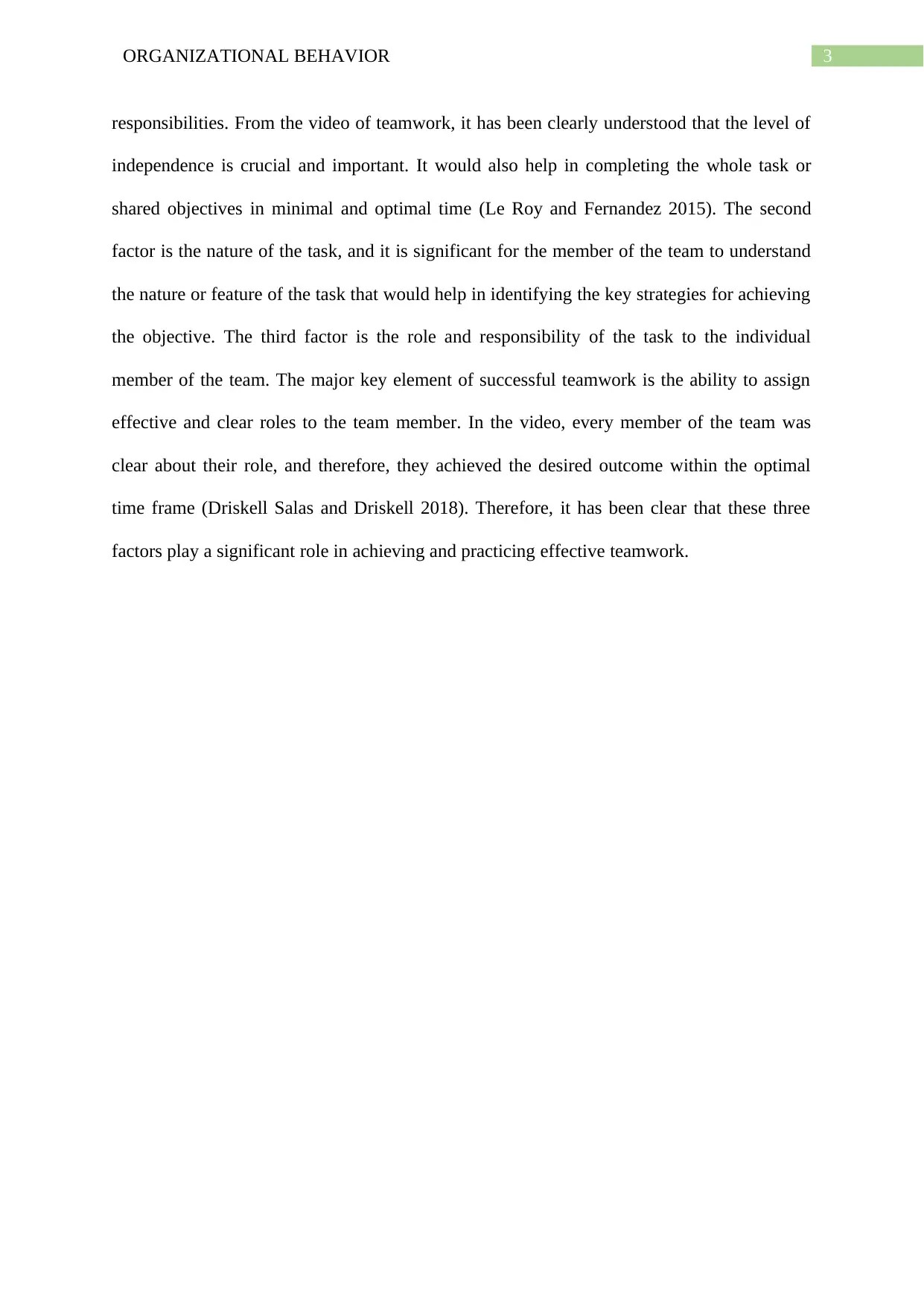
3ORGANIZATIONAL BEHAVIOR
responsibilities. From the video of teamwork, it has been clearly understood that the level of
independence is crucial and important. It would also help in completing the whole task or
shared objectives in minimal and optimal time (Le Roy and Fernandez 2015). The second
factor is the nature of the task, and it is significant for the member of the team to understand
the nature or feature of the task that would help in identifying the key strategies for achieving
the objective. The third factor is the role and responsibility of the task to the individual
member of the team. The major key element of successful teamwork is the ability to assign
effective and clear roles to the team member. In the video, every member of the team was
clear about their role, and therefore, they achieved the desired outcome within the optimal
time frame (Driskell Salas and Driskell 2018). Therefore, it has been clear that these three
factors play a significant role in achieving and practicing effective teamwork.
responsibilities. From the video of teamwork, it has been clearly understood that the level of
independence is crucial and important. It would also help in completing the whole task or
shared objectives in minimal and optimal time (Le Roy and Fernandez 2015). The second
factor is the nature of the task, and it is significant for the member of the team to understand
the nature or feature of the task that would help in identifying the key strategies for achieving
the objective. The third factor is the role and responsibility of the task to the individual
member of the team. The major key element of successful teamwork is the ability to assign
effective and clear roles to the team member. In the video, every member of the team was
clear about their role, and therefore, they achieved the desired outcome within the optimal
time frame (Driskell Salas and Driskell 2018). Therefore, it has been clear that these three
factors play a significant role in achieving and practicing effective teamwork.
Paraphrase This Document
Need a fresh take? Get an instant paraphrase of this document with our AI Paraphraser
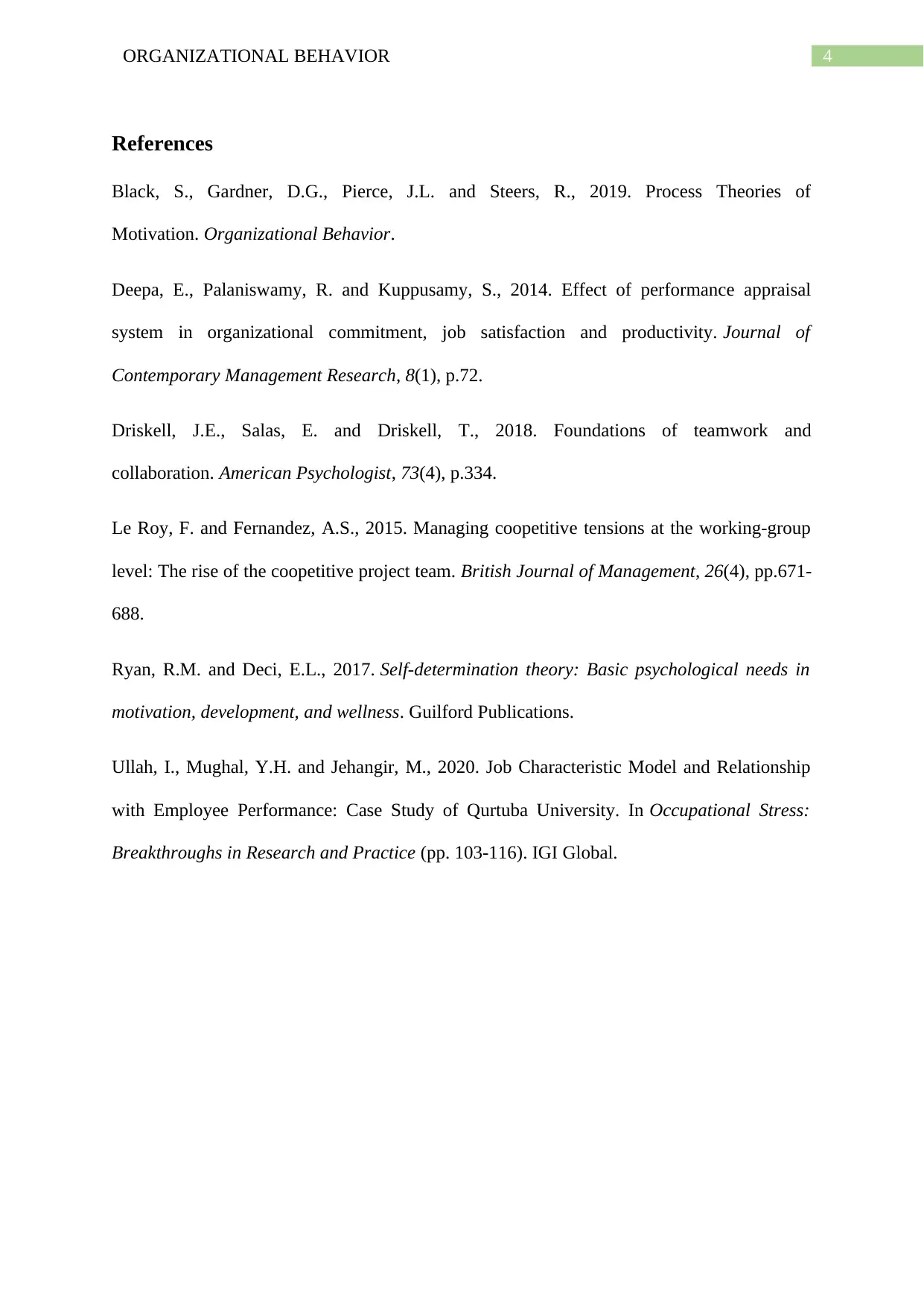
4ORGANIZATIONAL BEHAVIOR
References
Black, S., Gardner, D.G., Pierce, J.L. and Steers, R., 2019. Process Theories of
Motivation. Organizational Behavior.
Deepa, E., Palaniswamy, R. and Kuppusamy, S., 2014. Effect of performance appraisal
system in organizational commitment, job satisfaction and productivity. Journal of
Contemporary Management Research, 8(1), p.72.
Driskell, J.E., Salas, E. and Driskell, T., 2018. Foundations of teamwork and
collaboration. American Psychologist, 73(4), p.334.
Le Roy, F. and Fernandez, A.S., 2015. Managing coopetitive tensions at the working‐group
level: The rise of the coopetitive project team. British Journal of Management, 26(4), pp.671-
688.
Ryan, R.M. and Deci, E.L., 2017. Self-determination theory: Basic psychological needs in
motivation, development, and wellness. Guilford Publications.
Ullah, I., Mughal, Y.H. and Jehangir, M., 2020. Job Characteristic Model and Relationship
with Employee Performance: Case Study of Qurtuba University. In Occupational Stress:
Breakthroughs in Research and Practice (pp. 103-116). IGI Global.
References
Black, S., Gardner, D.G., Pierce, J.L. and Steers, R., 2019. Process Theories of
Motivation. Organizational Behavior.
Deepa, E., Palaniswamy, R. and Kuppusamy, S., 2014. Effect of performance appraisal
system in organizational commitment, job satisfaction and productivity. Journal of
Contemporary Management Research, 8(1), p.72.
Driskell, J.E., Salas, E. and Driskell, T., 2018. Foundations of teamwork and
collaboration. American Psychologist, 73(4), p.334.
Le Roy, F. and Fernandez, A.S., 2015. Managing coopetitive tensions at the working‐group
level: The rise of the coopetitive project team. British Journal of Management, 26(4), pp.671-
688.
Ryan, R.M. and Deci, E.L., 2017. Self-determination theory: Basic psychological needs in
motivation, development, and wellness. Guilford Publications.
Ullah, I., Mughal, Y.H. and Jehangir, M., 2020. Job Characteristic Model and Relationship
with Employee Performance: Case Study of Qurtuba University. In Occupational Stress:
Breakthroughs in Research and Practice (pp. 103-116). IGI Global.
1 out of 5
Related Documents
Your All-in-One AI-Powered Toolkit for Academic Success.
+13062052269
info@desklib.com
Available 24*7 on WhatsApp / Email
![[object Object]](/_next/static/media/star-bottom.7253800d.svg)
Unlock your academic potential
Copyright © 2020–2025 A2Z Services. All Rights Reserved. Developed and managed by ZUCOL.





